Christi Belcourt, a Metis and First Nations of Canada artist, was born in 1968 in Scarborough, Ontario. She now lives in Lac Ste Anne, Alberta.
Belcourt depicts traditional designs of the Metis people. They are of mixed race whose progenitors were First Nations women and European men, fur traders from France, England, and Scotland. They developed a language, government, and culture distinct from that of other indigenous people. The Manitoba Act of 1870 made the land of the Metis part of Canada. Belcourt’s paintings capture the Metis people’s appreciation of the beauty of the natural world and their deep concern for its preservation.

“Water Song” (2010-11)
The Metis people were known as the Flower Bead People. “Water Song” (2010-11) (80’’x231”) (acrylic) was inspired by one of their crafts. The canvas is covered with approximately 250,000 dots, applied with the tip of the paint brush. Clusters of roots in the water surround the lower edge of the composition. Burdock root flowers, their green leaves and small red berries are in the lowest and central section of the work. They are used for cleansing and women’s medicine. Plants included are the wild rose, trillium, blueberry, plantain, sundew, clubmoss, Indian pipe, shrink cabbage, lady’s slipper, yarrow, thistle, chokecherry, tamarack, maple, clover, nettles, red clover, maples, oak, pinecones, and strawberries, the first fruit of spring. Birds included are the downy woodpecker, barn owl, nuthatch, and northern flicker. Two warblers sing at the top of the painting. The small white flowers of a milkweed plant are placed at the center, with monarch butterflies at either side. Milkweed is a major food source for monarch butterflies, now an endangered species.

“Water Song” (detail)
This detail of the right side of the composition includes a yellow warbler singing. Beneath are pine cones and needles, and a barn owl. At the far left are the white dots of the milkweed and the monarch butterfly.
The painting attracted the attention of Dior designers Maria Grazia Chiuri and Pierpaolo Piccioli. With Belcourt’s permission, some of the 2016 Resort Collection featured designs from the painting. Belcourt explained that “A lot of the beadwork tradition and imagery that I work with was originally put on items that were for use of some sort, including clothing. And then in my painting practice, I took that imagery and practice of beadwork and transferred it into paint and put it onto canvas. So then to take this artwork that was done in paint and put it back onto clothing was almost like it had come full circle. That was exciting.”
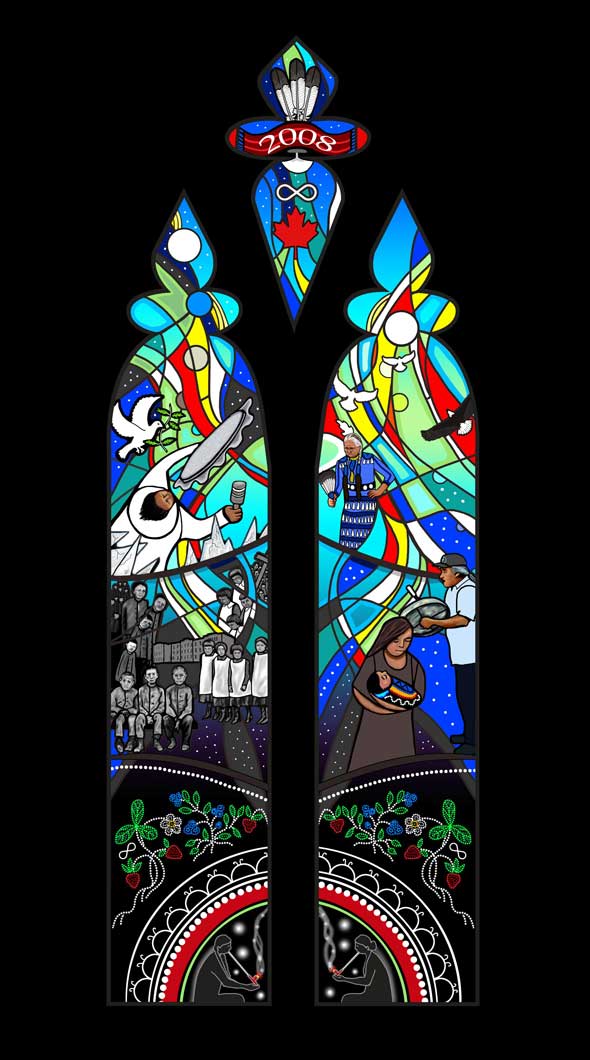
“Giniigaaniimenaaning (Looking Ahead) (2012)
“Giniigaaniimenaaning (Looking Ahead) (stain glass window) (2012), located in the Centre Block of the Parliament Building of Canada, represents the 2008 apology of the Canadian government to the indigenous people of Canada for the policy of placing children in Indian residential schools. The top panel includes the date 2008 and a female shape that integrates the Canadian maple leaf and feathers. The left panel includes the image in white of Phil Fontaine, the Grande Chief of the Assembly of Manitoba Chiefs, holding a drum and drum stick. In 1990, he was the first to speak out about his life in the residential school. Others began to speak out, and reconciliation began, represented by the white dove holding the olive branch. The shattered glass represents the lives that were shattered. The middle section, largely created in black and white glass, represents life in the schools. The top right side of the window commemorations the Apology to former students offered by Canadian Prime Minister Stephen Harper on June 11, 2008: “I am filled with optimism… a new day has dawned, a new day heralded by a commitment to reconciliation and building a new relationship with Inuit, Métis and First Nations.” The lines represent rays of sunshine. Doves and an eagle fly upward as if toward the future. A tribal elder wearing a “jingle dress” represents healing. The colors yellow, black, white, red, green, and blue are the colors used in medicine wheels, the sun dance, and lodges. The grandfather sings a traditional song to signify the restoration of the songs, dances, ceremonies, and languages of the people. The mother and child illustrate the return to traditional child rearing. At the bottom of both panels, the circle has been connected and is complete. Grandmothers sit in their lodges and smoke peacefully as traditions are restored. The strawberries hold a significant place in Metis culture as they are the first fruits of a new spring and represent a new beginning.
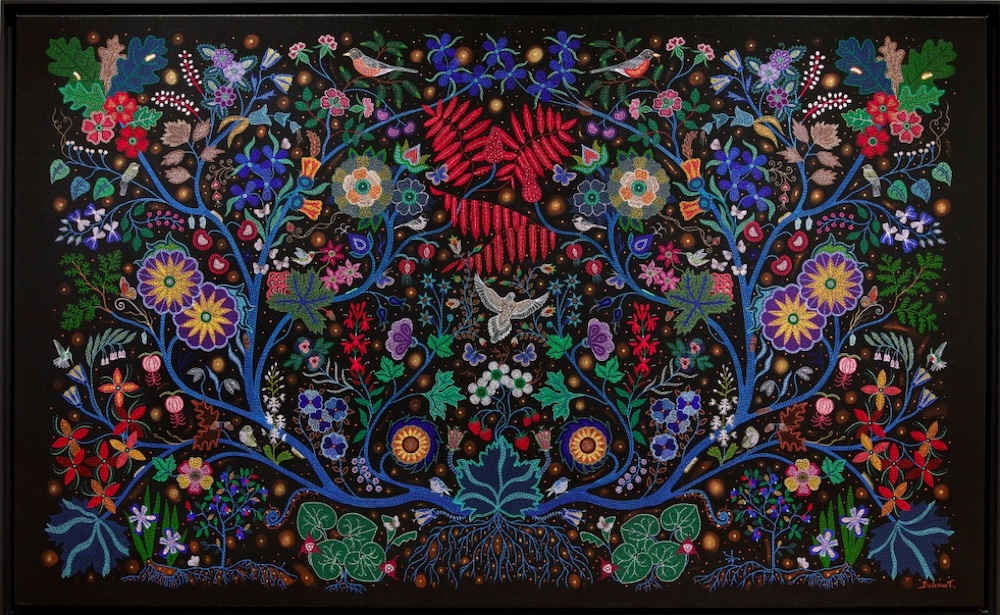
“Wisdom of the Universe” (2014)
Belcourt received the Ontario Arts Council Aboriginal Arts Award in 2014. “Wisdom of the Universe” (2014) (67×111’’) represents plants and animals that are on the endangered species list: Dwarf Lake Iris, Eastern Prairie Fringed Orchid, Karner Blue Butterfly, West Virginia White Butterfly, Spring Blue-eyed Mary, Cerulean Warbler, and Acadian Flycatcher. Belcourt writes stories or comments to go with many of the works. She wrote about this piece: “Globally, we live in a time of great upheaval. The state of the world is in crisis. We are witness to the unbearable suffering of species, including humans. Much of this we do to ourselves. It is possible for the planet to return to a state of well-being, but it requires a radical change in our thinking. It requires a willingness to be open to the idea that perhaps human beings have got it all wrong. All species, the lands, the waters are one beating organism that pulses like a heart. We are all a part of a whole. The animals and plants, lands and waters, are our relatives each with as much right to exist as we have…Perhaps it’s time to place the rights of Mother Earth ahead of the rights to Mother Earth.”
Belcourt is an advocate for other social and environmental causes. She initiated in 2011 the Walking with Our Sisters project, inspired by seeing too many posters about missing indigenous women: “One day, I saw one that hit me harder than usual, because the girl on the poster looked like my daughter.” In response to her Facebook appeal for 600 beaded moccasin tops for an exhibition to represent these women, 1,723 pairs were sent from all over the world, and 65 beading circle projects sprung up in Canada, United States, and Europe. The moccasin tops, called vamps, tongues, or uppers, were not sewn onto the moccasins to represent the unfinished lives of the missing women. The project toured in 30 Canadian and US locations from 2012 until 2019. Each exhibition was created specifically for each location.
From 2010 until 2013, Belcourt organized with Jon and Kerry Butler and Sophie Edwards an art project to protect Willisville Mountain, where several famous Canadian artists had made art history with their paintings. The Mountain, owned by a mining company, was under threat of being quarried, thus the destruction of the beauty of the famous area. The pressure of 45 artists caused the cancellation of the development, and the beauty of the mountain was preserved. She co-founded the Onaman Collective in 2014 to preserve traditional knowledge and language and to teach it to the young. The Collective raises awareness of the need to protect the Great Lakes and other bodies of water. Since 2017, proceeds from her works and awards have been donated to Nimkii Aazhibikong, a year-round camp to revitalize the Anishinaabemowin language among indigenous people. She is the author of at least four books, one on native medicines and another on Beadwork. She received in 2016 the Premier Arts Award and a Governor General’s Award for Innovation.
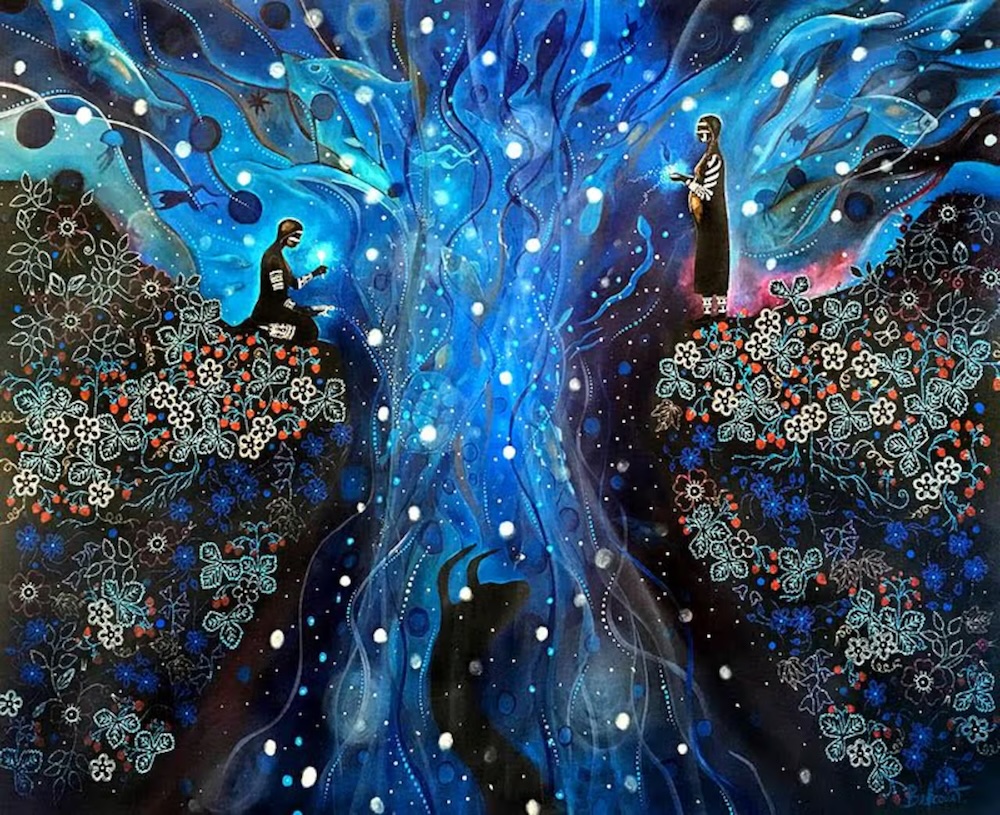
“Offerings to Save the World” (2017)
Belcourt continues to paint in her unique style, and she continues to add text for the viewer. In “Offerings to Save the World” (2017) (72’’x55’’) her focus once again is on water, and this time the painting takes on a mystical theme. Water spouts arise from the bottom of the canvas to reach the sky. Interwoven with the blue sky and water are stars, fish, and frogs. Two spiritual indigenous figures are placed on either side of the water. They bring offerings and pray. They sit and stand upon an abundance of flowers. A dark female figure appears to rise from the water.
The accompanying text: ‘’Quick! Drop everything. The future will look as the past. The Elders have foretold. Quick! Give everything. For every baby to be born. Of every species forever to come. Born into water. Born onto an earth of water. Quick! Go to the River. Bring your shaker. Sing to save the world. Quick! Go to the Water’s edge. Bring feast food. Give offerings to save the world. Mother Earth is the almighty.’’
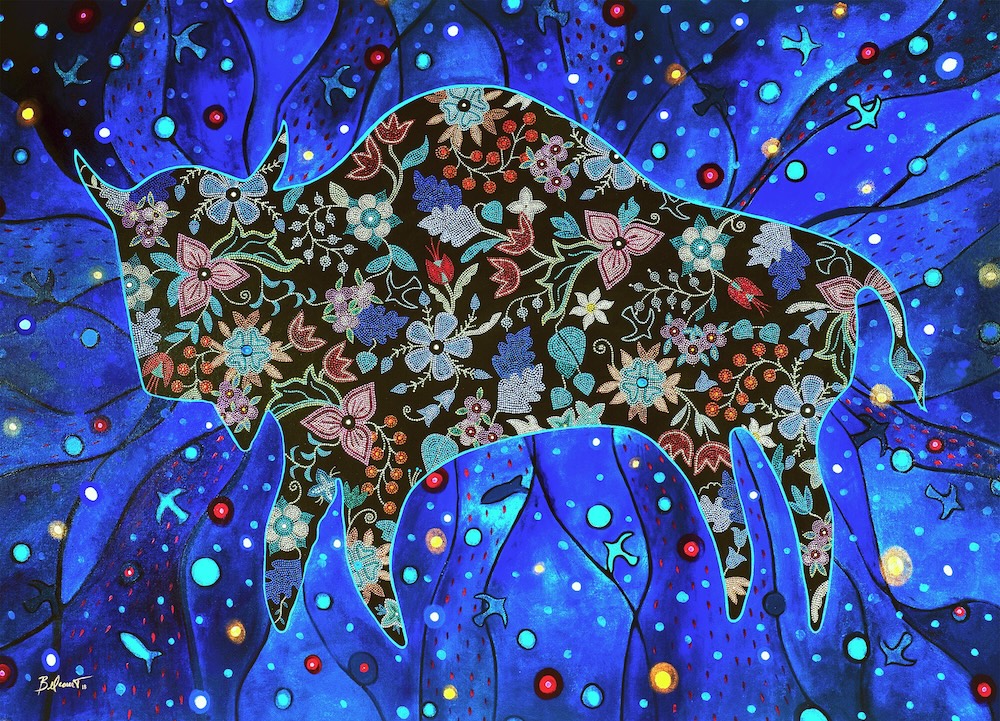
“The Earth is My Government” (2017)
“The Earth is My Government” (2017) (51’’x72’’) expresses another of Belcourt’s responses to the world in which she finds herself. The deep blue of the water and sky contain stars, birds, and fish. The spirit of the buffalo that had provided for many of the needs of indigenous people over hundreds of years also resides in this blue world. The buffalo shape contains the flower beading of the Metis. The Metis people were not recognized by Canada as indigenous peoples until 1982 in Section 35 of the Constitution Act. They finally obtained the right to self-government in 2019. Belcourt’s saying that the earth is my government can be understood better in these circumstances.
Remaining true to her strong beliefs, she protested that her name should be removed from the Metis Nation of Ontario registry because she disagreed with the deals that were being made with Energy East, Nuclear Waste Management Organization, and others. She was involved in establishing the 150 Acts of Resistance to counter the government’s “Canada 150” to celebrate the 250th anniversary of Canada in 2017. She said they were “ignoring basically all of the First Nations, Métis Nations and Inuit people that have been here for 15,000 years…The other thing is that we wanted to be able to showcase the good things that are happening in our nations that we should really be celebrating. We wanted to feature examples of history, of resistance, resilience and resurgence. All the restoration work being done on the grassroots level is really inspiring.” In 2023 she received an Honorary Doctorates in Visual Arts from Algoma University, Sault Ste. Marie, Ontario, and Doctor of Letters from Wilfrid Laurier University, Waterloo, Ontario.
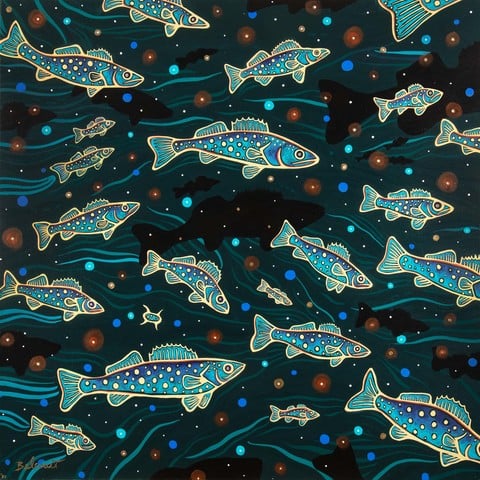
“I Envy Their Freedom” (2020)
“I Envy Their Freedom” (2020) (31”x31’’) reminds viewers how important water is to the world. The title is understandable in light of Belcourt’s continued battle to save the future of Earth. Rest is needed to continue the fight. Her process is a type of meditation. Each painting is meticulously executed with tiny dots, requiring an extraordinary amount of time and concentration, resulting in calm.
“I want all human beings to feel connected to the earth, because ultimately, we are all of this earth, and in becoming connected to the earth and to the waters, we are more likely to want to protect those for future generations. It is a form of expression of who I am that also, at its fundamental core, relates to all of us as human beings, who are living on this planet, with other beings who deserve to have a clean environment.” (Christi Belcourt)
Beverly Hall Smith was a professor of art history for 40 years. Since retiring to Chestertown with her husband Kurt in 2014, she has taught art history classes at WC-ALL and the Institute of Adult Learning, Centreville. An artist, she sometimes exhibits work at River Arts. She also paints sets for the Garfield Theater in Chestertown.



Write a Letter to the Editor on this Article
We encourage readers to offer their point of view on this article by submitting the following form. Editing is sometimes necessary and is done at the discretion of the editorial staff.